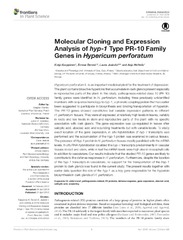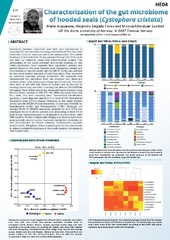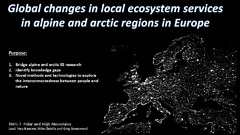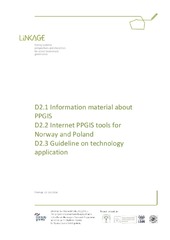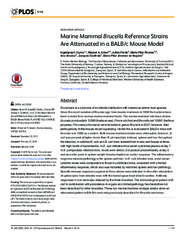Artikler, rapporter og annet (arktisk og marin biologi): Nye registreringer
Viser treff 1321-1340 av 1643
-
Molecular Cloning and Expression Analysis of hyp-1 Type PR-10 Family Genes in Hypericum perforatum
(Journal article; Tidsskriftartikkel; Peer reviewed, 2016-04-21)Hypericum perforatum L. is an important medicinal plant for the treatment of depression. The plant contains bioactive hypericins that accumulate in dark glands present especially in reproductive parts of the plant. In this study, pathogenesis-related class 10 (PR-10) family genes were identified in H. perforatum, including three previously unidentified members with sequence homology to hyp-1, a ... -
Geographical area and life history traits influence diet in an Arctic marine predator
(Journal article; Tidsskriftartikkel; Peer reviewed, 2016-05-19)Global changes are thought to affect most Arctic species, yet some populations are more at risk. Today, the Barents Sea ecoregion is suffering the strongest sea ice retreat ever measured; and these changes are suspected to modify food access and thus diet of several species. Biochemical diet tracers enable investigation of diet in species such as polar bears (Ursus maritimus). We examined ... -
The Map of Sea Turtle Rescue Centres in the Mediterranean
(Conference object; Konferansebidrag, 2016-09-12) -
Characterization of the gut microbiome of hooded seals (Cystophora cristata)
(Conference object; Konferansebidrag, 2016-03-14) -
Global changes in local ecosystem services in Alpine and Arctic regions in Europe (introduction)
(Conference object; Konferansebidrag, 2016-09-19) -
Good-bye to tropical alpine plant giants under warmer climates? Loss of range and genetic diversity in Lobelia rhynchopetalum
(Journal article; Tidsskriftartikkel; Peer reviewed, 2016-11-25)The main aim of this paper is to address consequences of climate warming on loss of habitat and genetic diversity in the enigmatic tropical alpine giant rosette plants using the Ethiopian endemic Lobelia rhynchopetalum as a model. We modeled the habitat suitability of L. rhynchopetalum and assessed how its range is affected under two climate models and four emission scenarios. We used three ... -
A probabilistic algorithm to process geolocation data
(Journal article; Tidsskriftartikkel; Peer reviewed, 2016-11-18)<p><i>Background: </i>The use of light level loggers (geolocators) to understand movements and distributions in terrestrial and marine vertebrates, particularly during the non-breeding period, has increased dramatically in recent years. However, inferring positions from light data is not straightforward, often relies on assumptions that are difficult to test, or includes an element of subjectivity ... -
Using Ordinary Digital Cameras in Place of Near-Infrared Sensors to Derive Vegetation Indices for Phenology Studies of High Arctic Vegetation
(Journal article; Tidsskriftartikkel; Peer reviewed, 2016)To remotely monitor vegetation at temporal and spatial resolutions unobtainable with satellite-based systems, near remote sensing systems must be employed. To this extent we used Normalized Difference Vegetation Index NDVI sensors and normal digital cameras to monitor the greenness of six different but common and widespread High Arctic plant species/groups (graminoid/Salix polaris; Cassiope tetragona; ... -
Seasonal vertical strategies in a high-Arctic coastal zooplankton community
(Journal article; Tidsskriftartikkel; Peer reviewed, 2016-08-18)We studied the larger (>1000 µm) size fraction of zooplankton in an Arctic coastal water community in Billefjorden, Svalbard (78°40’ N), Norway, in order to describe seasonal vertical distributions of the dominant taxa in relation to environmental variability. Calanus spp. numerically dominated the herbivores; Aglantha digitale, Mertensia ovum, Beroë cucumis, and Parasagitta elegans were the ... -
Development and evaluation of internet-based PPGIS
(Research report; Forskningsrapport, 2014-10-15) -
Effects of chronic dietary petroleum exposure on reproductive development in polar cod (Boreogadus saida)
(Journal article; Tidsskriftartikkel; Peer reviewed, 2016-10-04)Increasing human activities in the Arctic raise the risk of petroleum pollution, thus posing an elevated risk for Arctic organisms to be chronically exposed to petroleum compounds. The endocrine disrupting properties of some of these compounds (i.e. polycyclic aromatic hydrocarbons [PAHs]) present in crude oil may have negative effects on the long and energy intensive reproductive development of ... -
An empirical evaluation of spatial value transfer methods for identifying cultural ecosystem services
(Journal article; Tidsskriftartikkel; Peer reviewed, 2016-04-09)A significant barrier to the assessment of ecosystem services is a lack of primary data, especially for cultural ecosystem services. Spatial value transfer, also known as benefits transfer, is a method to identify the probable locations of ecosystem services based on empirical spatial associations found in other geographic locations. To date, there has been no systematic evaluation of spatial value ... -
Rumen and Cecum Microbiomes in Reindeer (Rangifer tarandus tarandus) Are Changed in Response to a Lichen Diet and May Affect Enteric Methane Emissions
(Journal article; Tidsskriftartikkel; Peer reviewed, 2016-05-09)Reindeer (Rangifer tarandus tarandus) are large Holarctic herbivores whose heterogeneous diet has led to the development of a unique gastrointestinal microbiota, essential for the digestion of arctic flora, which may include a large proportion of lichens during winter. Lichens are rich in plant secondary metabolites, which may affect members of the gut microbial consortium, such as the methane-producing ... -
A first insight into the fecal microbiota of the high Arctic muskoxen (Ovibos moschatus)
(Journal article; Tidsskriftartikkel, 2016-07-11)The faecal microbiota of muskoxen (n=3) pasturing on Ryøya (69° 33′ N 18° 43′ E), Norway, in late September was characterized using high-throughput sequencing of partial 16S rRNA gene regions. A total of 16 209 high-quality sequence reads from bacterial domains and 19 462 from archaea were generated. Preliminary taxonomic classifications of 806 bacterial operational taxonomic units (OTUs) resulted ... -
Changing Arctic snow cover: A review of recent developments and assessment of future needs for observations, modelling, and impacts
(Journal article; Tidsskriftartikkel; Peer reviewed, 2016-03-17)Snow is a critically important and rapidly changing feature of the Arctic. However, snow-cover and snowpack conditions change through time pose challenges for measuring and prediction of snow. Plausible scenarios of how Arctic snow cover will respond to changing Arctic climate are important for impact assessments and adaptation strategies. Although much progress has been made in understanding ... -
Herding conditions related to infectious keratoconjunctivitis in semi-domesticated reindeer: a questionnaire-based survey among reindeer herders
(Journal article; Peer reviewed; Tidsskriftartikkel, 2016-04-12)Background: Infectious keratoconjunctivitis (IKC) in Eurasian semi-domesticated reindeer (Rangifer tarandus tarandus) is a multifactorial disease, associated to infectious agents such as Cervid herpesvirus 2 (CvHV2) and various species of bacteria, but environmental factors may also be necessary to initiate the disease. Little effort seems to have been invested in addressing the herder`s experience ... -
Marine Mammal Brucella Reference Strains Are Attenuated in a BALB/c Mouse Model
(Journal article; Peer reviewed; Tidsskriftartikkel, 2016-03-09)Brucellosis is a zoonosis of worldwide distribution with numerous animal host species. Since the novel isolation of Brucella spp. from marine mammals in 1994 the bacteria have been isolated from various marine mammal hosts. The marine mammal reference strains Brucella pinnipedialis 12890 (harbour seal, Phoca vitulina) and Brucella ceti 12891 (harbour porpoise, Phocoena phocoena) were included in ... -
Under the snow: a new camera trap opens the white box of subnivean ecology
(Journal article; Tidsskriftartikkel; Peer reviewed, 2015-05-14)Snow covers the ground over large parts of the world for a substantial portion of the year. Yet very few methods are available to quantify biotic variables below the snow, with most studies of subnivean ecological processes relying on comparisons of data before and after the snow cover season. We developed a camera trap prototype to quantify subnivean small mammal activity. The trap consists of a ... -
Breeding persistence of Slavonian Grebe (Podiceps auritus) at long-term monitoring sites: predictors of a steep decline at the northern European range limit
(Journal article; Tidsskriftartikkel; Peer reviewed, 2015-06-10)The Slavonian Grebe (Podiceps auritus) has its European northern range limit in northern Norway, and is a species of national conservation concern due to its small population size and unknown population trend. Long-term monitoring at the range limit suggests breeding site use is in decline. We used annual occupancy data from 104 breeding lakes monitored since 1991 in northern Norway to investigate ... -
Reindeer and tundra in a changing world: threats and opportunities (språk: engelsk og samisk)
(Conference object; Konferansebidrag, 2015-10-15)


 English
English norsk
norsk